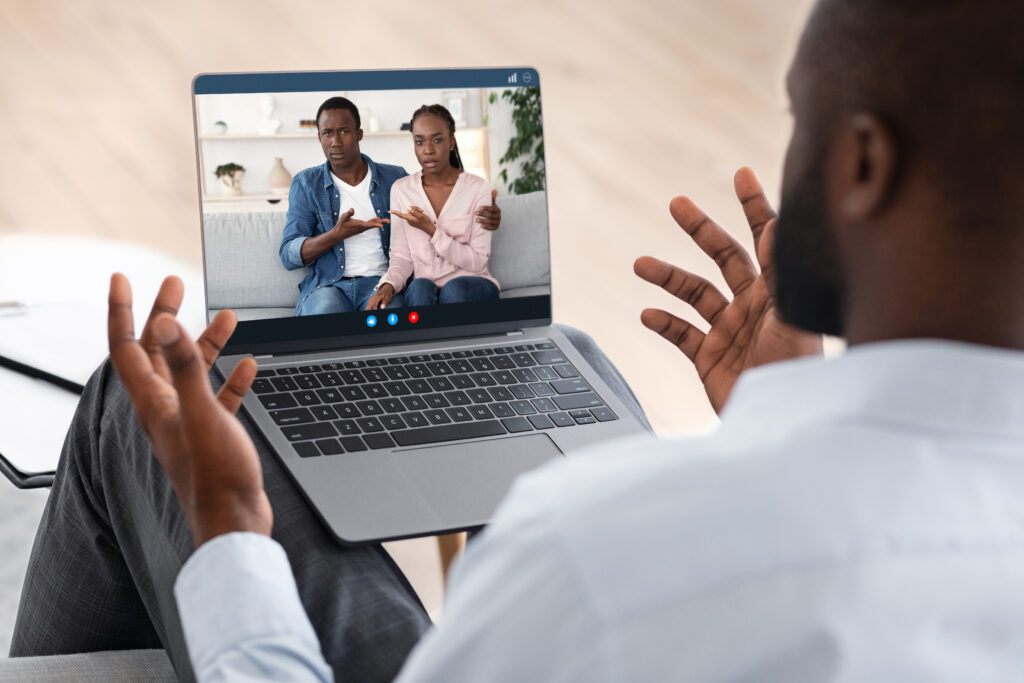Lockdowns have caused people to stay at home longer than usual. While it did bring couples together physically, it may have also caused mental, emotional, and sometimes, physical stress to their relationship.
Good thing couple’s therapy can now happen online. While the pandemic limited face-to-face interactions, everybody turned to virtual therapy and found the next best alternative. But when everything is slowly getting back to normal, should you also get back to your therapist’s office for in-person therapy sessions?
If you’re going to choose between online vs in-person therapy, therapists believe it’s better to choose the latter. While teletherapy or video therapy is more accessible, in-person therapy sessions are still the most effective.
Let’s dig deeper down each of them to help you understand why in-person therapy sessions for couples are still the best way to achieve great results, as told by experts in the field.
Why people choose Online therapy/ Online Counseling?
As the name suggests, online therapy takes place over a virtual platform. Instead of sitting with your therapist or counselor in an office, you can conduct sessions from anywhere with internet access.
Some research indicates that online sessions can be just as effective as in-person therapy. There are nuances to this though. The effectiveness of online therapy is largely based on one-on-one, communication-based sessions. Here are the main pros and cons to keep in mind.
Online Therapy can be good when:
Scheduling during busy days
With online therapy, you don’t have to plan around a meeting scheduled in the middle of your day. Your therapist can conduct a session virtually, making it easy to connect with them via a mobile device anywhere you are.
One-on-one sessions are pretty comparable with in-person ones if you can create the right conditions. They’re a convenient way to ensure you don’t miss meetings, making them a good backup for in-person therapy too. However, like any important meeting or event, it’s still best to make time for each of your therapy sessions.
It’s not accessible for you
Online therapy can open up your options when obstacles limit your access to healthcare. If you live in a remote area, for example, or can’t find the help you need locally, online therapy can help you find the support you need.
It removes the logistics and costs of traveling between sessions too. If you have reservations about being out in public, remote therapy is great because it doesn’t need you to leave your home.
You need an affordable option
Depending on the healthcare provider you go with, online counseling may be more affordable. Facilities and professionals who focus on virtual care typically have fewer overhead costs. Moreover, some insurance companies cover online therapy too, although you should always check with your provider first.
Online/ Virtual Therapy won’t work with:
Couple’s therapy
Studies may suggest that virtual sessions work best for cognitive behavioral therapy (CBT) in particular. However, it does lose some effectiveness with services like couples counseling. Here’s what therapists are saying:
“When couples didn’t choose to sit together in a session but far apart on a couch, that tells us something. When they don’t look at each other but only at the therapist, that tells us something. We’re losing so much valuable information about what is happening with a couple when we have their whole body in front of us.”
Moreover, fitting two people into one screen creates physical proximity that can make sessions uncomfortable for one or both parties. Using two different devices for a three-way conference can be just as awkward and disconnected. A virtual setup makes finding the balance inherent to in-person counseling harder.

Offscreen cues
Even in a one-on-one virtual session, a therapist can only see what’s on-screen, which is usually just the client’s face. This limits the range of nonverbal cues they can pick up during sessions. A client can keep a perfectly neutral face while showing behavioral signs that can’t be seen like clenched fists and bouncy knees.
Therapists use these cues to get real-time insight into client reactions. It’s useful, non-intrusive information a therapist can use to guide the session in ways that benefit you. A virtual session limits this window to facial expressions, which we tend to guard more anyway. A therapist once told us of this story:
“I had a client who I met first on video and she was hard to read because she was expressing that she was not upset — her face didn’t register anything. When she came to the office, our pet was lying with his head in her lap. She had the same expressionless face, but was petting him so assertively that she had a pile of his fur on the couch at the end of the session. We have learned how to hide things with our face but our body language tells the therapist otherwise.”
Out-of-state coverage
While many insurance companies do cover online therapy, they may not cover out-of-state providers. Again, it’s best to check with your insurer. But if that is the case, it may limit your options for online therapy.
There are also cases where insurers may cover out-of-state providers, but only for a limited time. That can range anywhere from 10-30 days. If you’re looking for long-term support with a consistent therapist, this can make it tricky. It’s not always the case, but it is a consideration unique to online therapy.
Why is In-Person Therapy better?
In-person therapy is what we’re traditionally used to. Its many forms developed around providing direct care in real space. As a result, in-person sessions tend to align closer with the best practices for healthcare. That said, it always helps to set realistic expectations for every kind of therapy.
But what can you get out of in-person therapy and what do you need to consider?
In-Person Therapy is best because:
Sessions are more focused
Whether sessions happen in an office or a mutual meeting area, they remove the distractions commonly found in virtual sessions. With online therapy, you may be at home, at work, in the parking lot, etc. While this makes scheduling easier, you’re dealing with more external factors that can pull your focus away.
In-person sessions create an environment with stronger boundaries, where it’s easier to concentrate. This isn’t just because you’re in a private space, but your therapist is also there to actively curate it for your benefit. They know the distractions you may not consider filtering out, and they’re proactive about getting you in the best headspace to start.
It offers wider range of services
Online therapy works best for individual sessions and CBT in particular. Almost every other therapy style was created based on in-person therapy. This offers you a wider range of services when looking for professional support.
Couples counseling is less stressful because in-person sessions put both parties in a neutral environment. There’s a counselor present to regulate the space and no one feels like they have a “home ground” advantage.
Uninterrupted privacy
Depending on where you have a virtual session, you may not be able to control access to your space. While more flexible scheduling is great, it works best when there isn’t much traffic around, which isn’t always the case when fitting virtual appointments into a busy day.
With in-person therapy, there’s a much higher guarantee of privacy. A therapist’s office is a secure area, disconnected from the outside world. When you’re there, you speak directly to one person, safe in the knowledge that you can be as vulnerable as you need to be.
It removes technology as a “middle man” for communication, so you don’t have to rely on texts or private video channels. While those channels are (and should be) secure enough for virtual sessions, the comfort of a closed door is hard to replicate. A therapist shares her experience about this:
“We are losing something in sessions from technology distractions. Clients are often looking at email messages that are popping up on the bottom of their screen or I see a finger dragging away a text message when they are having a session on their phone. These distractions would not be there if we were in a physical session.”
What won’t happen during In-Person Therapy:
Less or no travels
At the start of 2020, online therapy’s popularity was a direct response to the complications of meeting in person. Virtual sessions allowed people to connect remotely, making it easier to social distance in general and isolate when needed.
While healthcare providers across the industry have worked hard to make in-person care as safe as possible, you still need to travel to them. Depending on your living situation, this could be a five-minute walk or a drive across the city.
Multi-tasking during appointments
With in-person therapy, you’ll need to arrange your schedule around appointments instead of the other way around. This means factoring in the session itself, and travel times to and from it. Most mental healthcare providers try to give you as many scheduling options as possible, but you still need to plan around a larger chunk of time.
Same costs
Most online and in-person therapy options cost the same, however, the latter may come with additional travel costs: gas, parking, and traffic are some of them. In general, though, in-person therapy tends to be a tad pricier because providers have to factor in the overhead costs of running a facility. But then again, if results truly matter, is it not worth your time and a little gas money?
Online vs In-Person Therapy: What’s our verdict?
Ultimately, the best therapy option for you depends entirely on your needs. You can use the given situations to assess where the value lies for you. The goal is always to get the most out of resources and limit the obstacles in your path.
Online therapy offers convenience, even if you start in-person. Once you’ve established a connection with a therapist in real life, virtual sessions are a great way to continue. They make it easier to get care on a lunch break or between other obligations. And hey, you don’t need to get out of your yoga pants for a virtual session!
Where possible, however, we would recommend looking at in-person therapy. It can cost a little more and scheduling takes some planning, but in-person sessions are still the most effective across the board. There’s greater value out of the closeness, privacy, and focused care you get when you sit down with a professional.
To give you a little more vision on why you should opt for in-person therapy over online, here’s what therapists think you should know:
“There is an energy that happens in the room when you are working with someone who can hold space for you as you cry or express sadness that gets lost in translation, or bad connections that have grainy video. “
In-person sessions create stronger boundaries around a vulnerable space. They also give your therapist much more information when tailoring sessions. No matter which option you go for, we hope this guide has helped you identify the best support for your mental healthcare.
So what do you think will work best for you? These are great things to consider before getting decided with your spouse. But online or in-person, you can always count on our experts to help you. Talk to us today if you need guidance or assistance.

